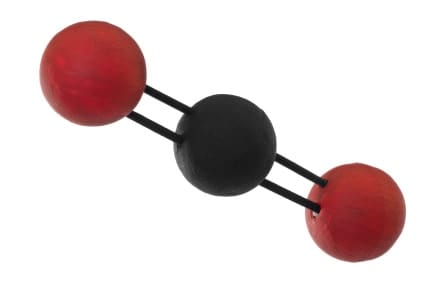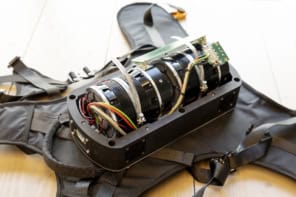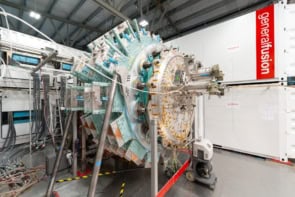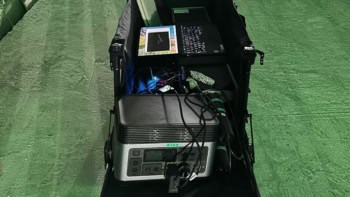
A new way to carbon-date old samples has been developed by physicists in Italy. Unlike current methods, which involve large and costly laboratory equipment, the new technique can be performed using portable and low-cost equipment. The researchers claim that their idea could have other applications, including biomedical procedures, environmental monitoring, fundamental physics and explosives detection.
Carbon dating is an essential tool of modern archaeology because it allows the age of a biological sample to be determined from the radioactivity of its carbon compounds. Carbon-14 is a radioactive isotope produced in the upper atmosphere by cosmic rays and accounts for one in every 1012 atoms of carbon in every living organism. When an organism dies, it stops taking in carbon, so the number of carbon-14 atoms decreases with a half-life of about 5730 years – a timescale that makes it ideal for investigating human history.
However, for samples aged around 50,000 years or older, accelerator mass spectrometry (AMS) is the only method that is sensitive enough to detect the minute amounts of remaining carbon-14. This involves ionizing the carbon compounds, accelerating them to extremely high energies with a particle accelerator and bending the ions’ paths with an electric field. The equipment required to do this is extremely large and costly.
Focusing on vibrations
Now, Paolo de Natale and colleagues of the National Institute of Optics and the European Laboratory for Non-Linear Spectroscopy, both in Florence, Italy, have developed a much cheaper alternative that they say is almost as sensitive. This new method is based on infrared laser spectroscopy, which probes the quantized vibrational modes of molecules. A specific type of molecule will absorb infrared light only at energies corresponding to its vibrational modes. Therefore, the concentration of a particular molecule in a sample can be measured by tuning a laser to the appropriate energy and measuring how much light is absorbed.
The vibrational modes of carbon dioxide differ slightly depending on whether the carbon atom is carbon-14 or standard carbon-12. By burning a sample and performing infrared laser spectroscopy on the carbon dioxide produced, scientists can work out the proportion of carbon-14 in the original sample and thus deduce its age. However, owing to fluctuations in the output of the laser, this has never been sensitive enough to use for dating.
De Natale and colleagues have overcome this problem by using a technique they first unveiled last year, called saturated absorption cavity ring-down (SCAR) spectroscopy. SCAR involves firing the laser into a cavity with a mirror at either end – essentially “filling” the cavity with light that bounces back and forth. The laser is switched off and a measurement is made of the rate at which the intensity of the light in the cavity decays or “rings down”. A SCAR measurement is made with the cavity filled with the carbon-dioxide sample, which affects the decay rate because light is absorbed by the molecules. Because the laser light is injected into the cavity in advance and switched off during the measurement, SCAR is not affected by fluctuations in laser intensity. Another benefit of the technique is that the multiple reflections ensure that the light interacts with the gas for a much longer time than if the laser were just fired through a sample.
Room for improvement
By measuring how quickly the sample absorbed the laser light, the researchers were able to work out the proportion of carbon-14 that it contained. They measured concentrations of radiocarbon as low as four parts in 1014. The very best AMS machines – which are 10 times as expensive and 100 times the size of the SCAR prototype – can achieve one part in 1015, but De Natale believes their system can be improved further. He points out that carbon-14 is also used for biomedical applications in which AMS accuracy levels are not needed. “There are small-scale mass spectrometers that could in principle be replaced [by SCAR] now, even though the ultimate sensitivity is not yet at the level of the best mass spectrometers,” he explains.
De Natale says that, in future, the technique could be adapted to detect tiny quantities of other rare molecules. This could allow it to be used to monitor the concentrations of hazardous pollutants in the environment, to detect drugs or explosives on passengers or in cargo at airports or to conduct research in fundamental physics.
“It is an incredibly sensitive measurement of a very small quantity of this very rare isotope,” says David Nelson, atmospheric scientist at Aerodyne Research in the US. However, he points out that the technique benefits from the fact that carbon dioxide “has an extraordinarily strong infrared line strength. So while you could certainly use this technique with other molecules, you won’t get the same sensitivity”.
The research will be described in an upcoming issue of Physical Review Letters.



